Week 1: March 28 – April 3, 2012
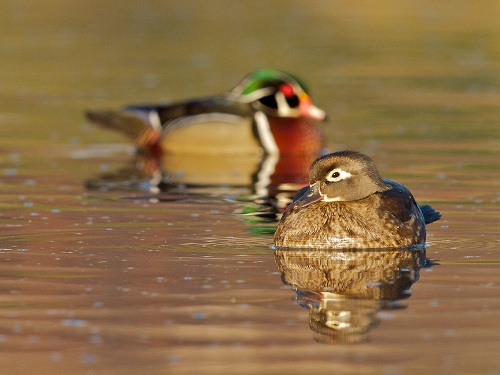 One of the pairs of Wood Ducks settling back in at MBO for another year. (Photo by Simon Duval) One of the pairs of Wood Ducks settling back in at MBO for another year. (Photo by Simon Duval) |
| THIS WEEK | THIS SPRING | 2012 TOTAL | SITE TOTAL | |
|---|---|---|---|---|
| # birds (and species) banded | – | – | 75 (10) | 35826 (108) |
| # birds (and species) repeat | – | – | 14 (4) | 6427 (68) |
| # birds (and species) return | – | – | 26 (6) | 987 (37) |
| # species observed | 35 | 35 | 53 | 204 |
| # net hours | – | – | 63.7 | 59162.9 |
| # birds banded / 100 net hours | – | – | 117.7 | 60.6 |
Note: table does not include nocturnal banding (owls)
Banders-in-charge: Simon Duval, Gay Gruner
Censusers: Jean Demers, Barbara Frei, Barbara MacDuff, Betsy Mcfarlane, Clémence Soulard, Victor Thamasson, Elise Titman, Rodger Titman
Maintenance day volunteers: Alex Bernal, Robert Boule, Jean Demers, Barbara Frei, Alison Hackney, Malcolm Johnson, Norsola Johnson, James Junda, Francine Marcoux, Betsy McFarlane, Chris Murphy, Mariner Palmer, Andrew Patterson, Clémence Soulard, Chick Taylor, Chris Taylor, Elise Titman, Rodger Titman, Victor Thomasson, Bruno Tremblay
Notes: After record high temperatures in March, a cold front came through for the first week of our Spring Migration Monitoring Program, pushing temperatures below normal for this time of year, and depositing a dusting of snow. However, the 35 species observed this week were close to average for the first week of the spring season. New species for the year were American Bittern (our earliest ever), Tree Swallow, Red-breasted Nuthatch, and Winter Wren.
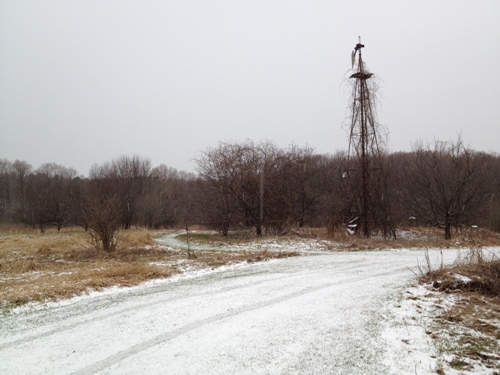 The scene awaiting censusers on the first day of our 2012 spring season – a sharp contrast to the five straight days of temperatures in the 20s just a week earlier. (Photo by Simon Duval) The scene awaiting censusers on the first day of our 2012 spring season – a sharp contrast to the five straight days of temperatures in the 20s just a week earlier. (Photo by Simon Duval) |
| # individuals banded | mean # individuals observed daily |
|---|---|
| – | 1. Canada Goose (298) |
| – | 2. Red-winged Blackbird (42) |
| – | 3. American Crow (16) |
| – | 4. Black-capped Chickadee (15) |
| – | 5. American Robin (13) |
| – | 6. Ring-billed Gull (13) |
| – | 7. Mallard (12) |
| – | 8. Song Sparrow (11) |
| – | 9. Wood Duck (9) |
| – | 10. Blue Jay (8) |
As usual, the first three weeks of the spring program will be based primarily on the daily census, since weather is too often unsuitable for banding. Like in most previous years, Canada Goose was the most abundant species during week 1, with Red-winged Blackbird trailing by a substantial margin. American Crow, Black-capped Chickadee, American Robin, Ring-billed Gull, and Song Sparrow have also been in the top ten for week 1 each year. Reflecting the earlier than usual migration this year, Mallard and Wood Duck also made it into this week’s list. in contrast to last year when Bohemian and Cedar Waxwing were both in the top ten, this year we saw just a single Cedar Waxwing all week.
 As usual, early spring is an important time for site maintenance at MBO, especially ensuring that the trails are in good shape for the season. Tasks this year included replacing some of the boardwalks on the far side of Stoneycroft Pond, such as the one above. After a hard morning of work, the volunteer crew enjoyed a well-deserved barbecue, below – sincere thanks to all who helped! (Photos by Simon Duval) As usual, early spring is an important time for site maintenance at MBO, especially ensuring that the trails are in good shape for the season. Tasks this year included replacing some of the boardwalks on the far side of Stoneycroft Pond, such as the one above. After a hard morning of work, the volunteer crew enjoyed a well-deserved barbecue, below – sincere thanks to all who helped! (Photos by Simon Duval) |
Week 2: April 4 – 10, 2012
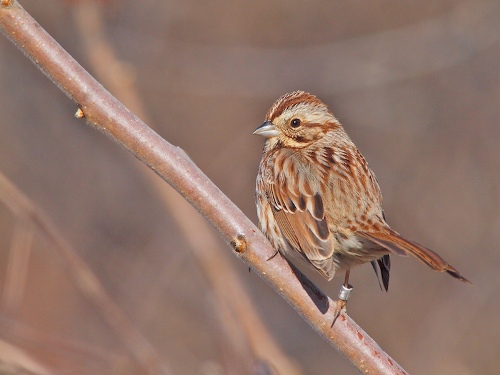 One of our local Song Sparrows back for another year; hopefully once the banding program resumes we can detetermine its identity and history. (Photo by Simon Duval) One of our local Song Sparrows back for another year; hopefully once the banding program resumes we can detetermine its identity and history. (Photo by Simon Duval) |
| THIS WEEK | THIS SPRING | 2012 TOTAL | SITE TOTAL | |
|---|---|---|---|---|
| # birds (and species) banded | – | – | 75 (10) | 35826 (108) |
| # birds (and species) repeat | – | – | 14 (4) | 6427 (68) |
| # birds (and species) return | – | – | 26 (6) | 987 (37) |
| # species observed | 41 | 46 | 57 | 204 |
| # net hours | – | – | 63.7 | 59162.9 |
| # birds banded / 100 net hours | – | – | 117.7 | 60.6 |
Note: table does not include nocturnal banding (owls)
Banders-in-charge: Simon Duval, Gay Gruner
Censusers: Jean Demers, Frédéric Hareau, James Junda, Barbara MacDuff, Karen Nassi
Notes: Temperatures were more seasonal this week, and daily census counts were consistently between 18 and 20 species, except for a midweek spike to 28 species on April 6 and 25 on April 7. Sharp-shinned Hawk, Cooper’s Hawk, Rock Pigeon, and Belted Kingfisher were observed for the first time this year, while we had our first spring observations of another seven species: Northern Goshawk, Mourning Dove, Northern Flicker, Eastern Phoebe, Brown Creeper, Golden-crowned Kinglet, and Chipping Sparrow.
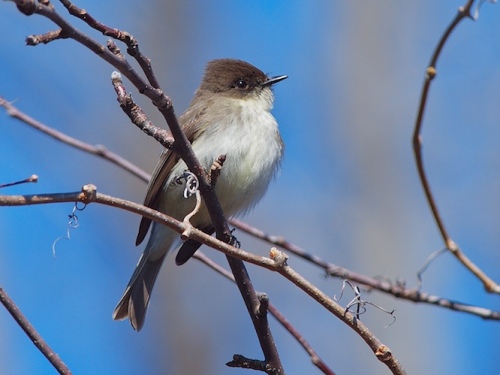 Eastern Phoebes were observed on census four times this week, hopefully establishing a territory as in many previous years. (Photo by Simon Duval) Eastern Phoebes were observed on census four times this week, hopefully establishing a territory as in many previous years. (Photo by Simon Duval) |
| # individuals banded | mean # individuals observed daily |
|---|---|
| – | 1. Canada Goose (162) [1] |
| – | 2. Red-winged Blackbird (29) [2] |
| – | 3. Ring-billed Gull (20) [6] |
| – | 4. Song Sparrow (13) [8] |
| – | 5. American Crow (12) [3] |
| – | 6. American Robin (12) [5] |
| – | 7. Black-capped Chickadee (11) [4] |
| – | 8. Wood Duck (9) [9] |
| – | 9. Slate-colored Junco (8) [-] |
| – | 10. Mallard (7) [7] |
Although a number of new species arrived at MBO this week, the most abundant birds were very similar to week 1, with only Blue Jay dropping out of the top ten, replaced by Slate-colored Junco. Canada Goose and Red-winged Blackbird remained in the top two spots, which is typical for the second week of spring. Song Sparrow numbers were slightly higher than average for this early in spring, while American Crow and American Robin were a bit lower than usual, and Black-capped Chickadee right on the mark compared to previous years. Wood Duck and Mallard made the top ten for a second straight week, both with numbers a fair bit higher than in previous years.
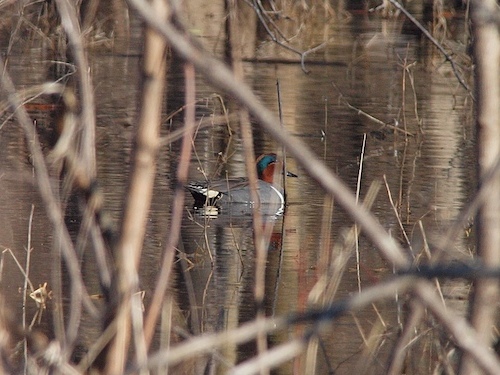 Waterfowl sightings have already been nicely varied this spring, including this male Green-winged Teal doing his best to elude the photographer. (Photo by Simon Duval) Waterfowl sightings have already been nicely varied this spring, including this male Green-winged Teal doing his best to elude the photographer. (Photo by Simon Duval) |
Week 3: April 11 – 17, 2012
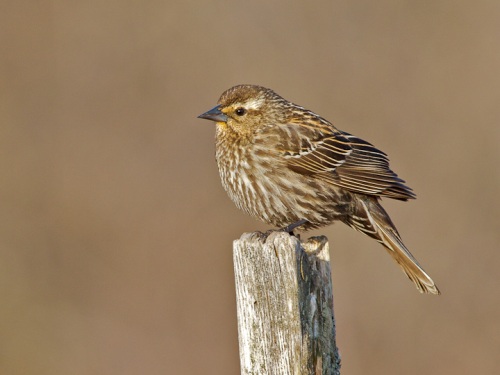 One of the many female Red-winged Blackbirds settling in at Stoneycroft Pond for another nesting season. (Photo by Simon Duval) One of the many female Red-winged Blackbirds settling in at Stoneycroft Pond for another nesting season. (Photo by Simon Duval) |
| THIS WEEK | THIS SPRING | 2012 TOTAL | SITE TOTAL | |
|---|---|---|---|---|
| # birds (and species) banded | – | – | 75 (10) | 35826 (108) |
| # birds (and species) repeat | – | – | 14 (4) | 6427 (68) |
| # birds (and species) return | – | – | 26 (6) | 987 (37) |
| # species observed | 45 | 55 | 63 | 204 |
| # net hours | – | – | 63.7 | 59162.9 |
| # birds banded / 100 net hours | – | – | 117.7 | 60.6 |
Note: table does not include nocturnal banding (owls)
Banders-in-charge: Simon Duval, Gay Gruner
Censusers: Sue Bishop, Barbara MacDuff, Betsy McFarlane, Ahmad Shah, Rodger and Elise Titman
Notes: The third week of spring provided a number of new arrivals to MBO, and boosted the total for the season to 55 species, above average for this time of year. A record early Common Loon was observed flying overhead, while we also recorded our first Merlin, Yellow-bellied Sapsucker, Swamp Sparrow, White-throated Sparrow, and Purple Finch of the year. Additionally, firsts for the season were American Black Duck, Northern Pintail, and Killdeer – all species that we observed already in the later part of winter. The 35 species observed on April 12 was an unusually high count for this time of year; other days this week the total ranged between 19 and 28, highlighting how much the situation can change from one day to the next during migration.
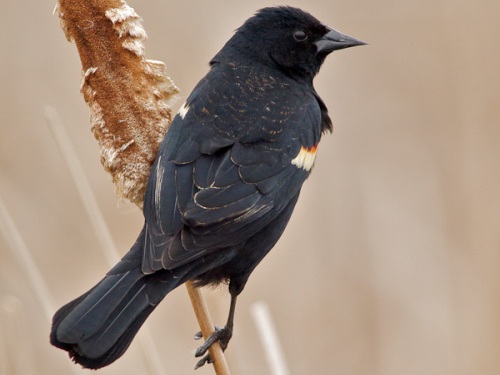 The male Red-winged Blackbirds have been back at MBO for a while already, but with the increase in female numbers, they are all the more intent on staking out their territories and claiming mates. (Photo by Simon Duval) The male Red-winged Blackbirds have been back at MBO for a while already, but with the increase in female numbers, they are all the more intent on staking out their territories and claiming mates. (Photo by Simon Duval) |
| # individuals banded | mean # individuals observed daily |
|---|---|
| – | 1. Canada Goose (101) [1] |
| – | 2. Red-winged Blackbird (42) [2] |
| – | 3. Cedar Waxwing (19) [-] |
| – | 4. American Crow (19) [5] |
| – | 5. Mallard (19) [10] |
| – | 6. Song Sparrow (16) [4] |
| – | 7. American Robin (14) [6] |
| – | 8. Wood Duck (12) [8] |
| – | 8. Black-capped Chickadee (12) [7] |
| – | 10. Ring-billed Gull (11) [3] |
Again this week there was just one new species among the ten most frequently observed birds (Cedar Waxwing, replacing Slate-colored Junco). Canada Goose remained the most abundant species for a third consecutive week, which is typical for this point in spring, and Red-winged Blackbird remained solidly in second place. Cedar Waxwing is rather erratic in spring, and has only rarely been this abundant so early in the season. Most of the other species on the list are also expected to be dominant at this time of year. Next week our spring banding program kicks off for another year, and we look forward to seeing what surprises await us.
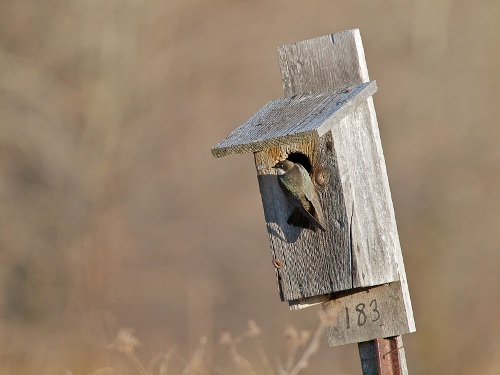 A second-year female Tree Swallow checking out one of the MBO nest boxes. (Photo by Simon Duval) A second-year female Tree Swallow checking out one of the MBO nest boxes. (Photo by Simon Duval) |
Week 4: April 18 – 24, 2012
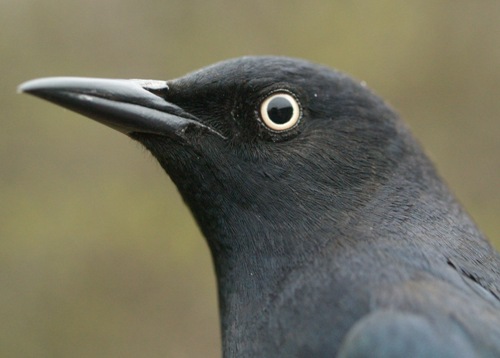 This Rusty Blackbird banded this week was only our eighth in 8 years of research. (Photo by Simon Duval) This Rusty Blackbird banded this week was only our eighth in 8 years of research. (Photo by Simon Duval) |
| THIS WEEK | THIS SPRING | 2012 TOTAL | SITE TOTAL | |
|---|---|---|---|---|
| # birds (and species) banded | 102 (19) | 102 (19) | 177 (23) | 35928 (108) |
| # birds (and species) repeat | 24 (6) | 24 (6) | 38 (8) | 6451 (68) |
| # birds (and species) return | 21 (6) | 21 (6) | 47 (8) | 1008 (38) |
| # species observed | 64 | 74 | 79 | 205 |
| # net hours | 346.0 | 346.0 | 409.8 | 59508.9 |
| # birds banded / 100 net hours | 29.5 | 29.5 | 43.2 | 60.4 |
Note: table does not include nocturnal banding (owls)
Banders-in-charge: Simon Duval, Gay Gruner
Assistants: Richard Beauchamp, Chris Cloutier, Yolande Cossette, David Davey, Jean Demers, Liette Fortier, Andray Gagné, Alison Hackney, Lisa Keelty, Louise LeBel, Barbara MacDuff, Francine Marcoux, Daniel Martin, Betsy McFarlane, Yves Paquette, Benoit Piquette, Rodger and Elise Titman, Monique Venne
Notes: We were excited this week to resume our banding program – but it was a surprise fly-by observation that was the undisputed highlight of the week. On April 20, Barbara MacDuff heard the distinct nasal call of a Fish Crow while on census, and Simon happened to be outside at the time and not only heard it too, but caught a glimpse of it flying past with some American Crows. It was seen briefly again just over half an hour later, again flying past; later in the morning it was seen a third time, feeding in the adjacent field with 50 American Crows, allowing the smaller size to be seen. At that location it repeated its nasal two-part call every few minutes; after a while the whole flock took off again, and the more rapid wingbeats of the Fish Crow were apparent in comparison to the American Crows. There was been an impressive influx of Fish Crows in southern Ontario over the past couple of months, but to our knowledge this is the first record for Quebec. We were unable to locate it again on subsequent days, but will definitely keep a close eye on the crows in case it returns – and encourage everyone else to look closely at crow flocks too!
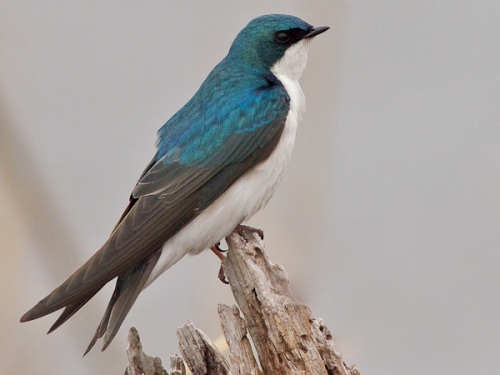 One of the many local Tree Swallows. (Photo by Simon Duval) One of the many local Tree Swallows. (Photo by Simon Duval) |
Aside from the Fish Crow, we observed 15 other species for the first time this year: Common Merganser, Double-crested Cormorant, Virginia Rail, Solitary Sandpiper, Greater Yellowlegs, Osprey, Northern Harrier, Bank Swallow, House Wren, Ruby-crowned Kinglet, Hermit Thrush, Palm Warbler, Vesper Sparrow, Savannah Sparrow, and Rusty Blackbird … plus we had another 3 new birds for spring that we also recorded in the late part of winter (Killdeer, Great Black-backed Gull, Fox Sparrow). Naturally all 19 species we banded this week were new for the season, but 14 of them were also new for 2012: Tree Swallow, Brown Creeper, Ruby-crowned Kinglet, Golden-crowned Kinglet, American Robin, Hermit Thrush, Western Palm Warbler, Northern Cardinal, Swamp Sparrow, White-throated Sparrow, Fox Sparrow, Red-winged Blackbird, Rusty Blackbird, and Purple Finch (while Downy Woodpecker, Blue Jay, American Tree Sparrow, Song Sparrow, and American Goldfinch were the 5 already banded at least once between January and March). Both the number of birds and the number of returns this week were somewhat above average for the first week of spring, while the 74 species observed so far is a record high, perhaps related to the unusually early arrival of spring this year. Among the returns was a White-throated Sparrow we banded at MBO in September 2009.
| # individuals banded | mean # individuals observed daily |
|---|---|
| 1. Red-winged Blackbird (21) | 1. Canada Goose (158) [1] |
| 2. Ruby-crowned Kinglet (20) | 2. American Robin (57) [7] |
| 3. White-throated Sparrow (18) | 3. Red-winged Blackbird (55) [2] |
| 4. Song Sparrow (10) | 4. American Crow (34) [4] |
| 5. Swamp Sparrow (7) | 5. White-throated Sparrow (23) [-] |
| 6. American Goldfinch (5) | 6. Black-capped Chickadee (20) [8] |
| 7. American Robin (4) | 7. Wood Duck (14) [8] |
| 8. Purple Finch (3) | 8. Song Sparrow (14) [6] |
| 9. Hermit Thrush (2) | 9. Ring-billed Gull (13) [10] |
| 9. American Tree Sparrow (2) | 10. Mallard (12) [5] |
| 9. Fox Sparrow (2) | 10. Ruby-crowned Kinglet (12) [-] |
Red-winged Blackbird narrowly edged Ruby-crowned Kinglet for the most frequently banded species this week, not surprising since both have been dominant in the first week of previous years. White-throated Sparrow was close behind in third place, much more numerous than in any previous year at this time. As usual for the first week of spring banding, several other sparrows made the top ten. The biggest surprises this week were Purple Finch (last banded in spring in 2009), and Hermit Thrush (only a single one banded across all previous spring programs, in sharp contrast to 339 banded in fall).
After a surprisingly dominant showing last week, Cedar Waxwing dropped back out of the top ten this week; new to the list thanks to a typical mid-April influx were Ruby-crowned Kinglet and White-throated Sparrow. The other species on the list were the same as last week, but American Robin numbers increased dramatically, while Mallards tapered off somewhat. The Wood Ducks remain a daily fixture, much to everyone’s delight.
 Although very common in fall, Hermit Thrushes are rare at MBO in spring – this was one of two banded this week, and only our third overall in 8 years of spring research. (Photo by Simon Duval) Although very common in fall, Hermit Thrushes are rare at MBO in spring – this was one of two banded this week, and only our third overall in 8 years of spring research. (Photo by Simon Duval) |
Week 5: April 25 – May 1, 2012
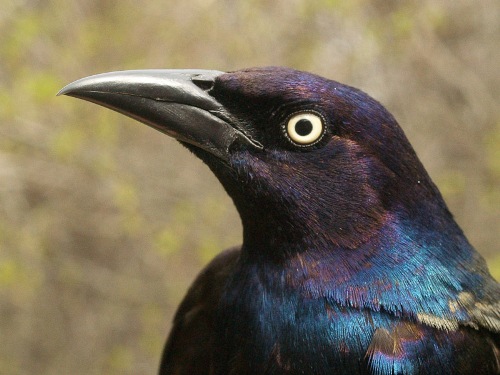 For contrast with the Rusty Blackbird we featured last week, here is one of the five Common Grackles banded at MBO this week. (Photo by Simon Duval) For contrast with the Rusty Blackbird we featured last week, here is one of the five Common Grackles banded at MBO this week. (Photo by Simon Duval) |
| THIS WEEK | THIS SPRING | 2012 TOTAL | SITE TOTAL | |
|---|---|---|---|---|
| # birds (and species) banded | 72 (16) | 174 (24) | 249 (27) | 36000 (108) |
| # birds (and species) repeat | 37 (8) | 61 (9) | 75 (11) | 6488 (68) |
| # birds (and species) return | 11 (4) | 32 (7) | 58 (9) | 1019 (38) |
| # species observed | 64 | 83 | 85 | 205 |
| # net hours | 389.0 | 735.0 | 798.8 | 59897.9 |
| # birds banded / 100 net hours | 18.3 | 23.5 | 31.2 | 60.1 |
Note: table does not include nocturnal banding (owls)
Banders-in-charge: Simon Duval, Gay Gruner
Assistants: Christine Barrie, Carl Bromwich, Yolande Cossette, David Davey, Jean Demers, Réjean Duval, Nicola Fleming, Louise Gagné, Sean Godwin, Alison Hackney, James Junda, Lisa Keelty, Barbara MacDuff, Francine Marcoux, Betsy McFarlane, Yves Payette, Benoit Piquette, Catherine Russell, Clémence Soulard, Rodger and Elise Titman, Yifu Wang
Notes: Migration was relatively slow this week, with some cool north winds holding back movement, and a couple of days largely rained out. However, that is typical for this time of year, and the 71 birds banded this week was in fact slightly above the mean of 66 across all previous years and brought us to exactly 36000 overall. However, the number of repeats this week was more than triple the average of 12 for week 5, and nearly double the previous record of 19 in 2008, reflecting the stagnancy of migration this week. The number of species observed in week 5 has varied widely across the years from a low of 55 to a high of 75, and the 64 species this week was right on the seven-year average.
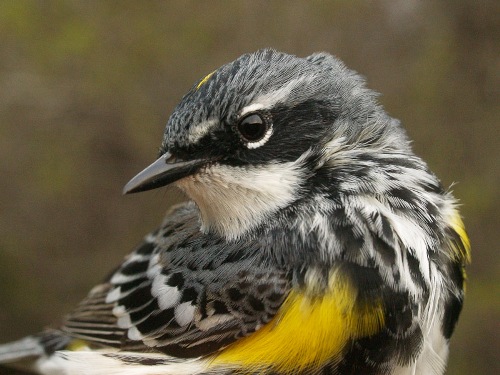 May will bring a rich variety of warblers to MBO, but as usual, the first of the season to arrive was Yellow-rumped Warbler. (Photo by Simon Duval) May will bring a rich variety of warblers to MBO, but as usual, the first of the season to arrive was Yellow-rumped Warbler. (Photo by Simon Duval) |
Birds observed for the first time this year were Broad-winged Hawk, Barn Swallow, Cliff Swallow, Brown Thrasher, Yellow-rumped Warbler, and Common Yellowthroat. In addition, we saw our first Greater Snow Geese, American Kestrel, and Pine Siskin of spring, although these were previously documented in late winter. We banded four more species for the first time this year (House Wren, Cedar Waxwing, Yellow-rumped Warbler, and Common Grackle), and Black-capped Chickadee for the first time this spring. Also of note this week we had our first Northern Cardinal return of 2012.
| # individuals banded | mean # individuals observed daily |
|---|---|
| 1. Red-winged Blackbird (13) [1] | 1. Red-winged Blackbird (83) [3] |
| 2. American Robin (12) [7] | 2. Canada Goose (69) [1] |
| 3. White-throated Sparrow (11) [3] | 3. American Crow (26) [4] |
| 4. Swamp Sparrow (7) [5] | 4. American Robin (21) [2] |
| 5. Common Grackle (5) [-] | 5. White-throated Sparrow (19) [5] |
| 6. Ruby-crowned Kinglet (4) [2] | 6. Song Sparrow (18) [8] |
| 6. Song Sparrow (4) [4] | 7. Black-capped Chickadee (17) [6] |
| 6. Fox Sparrow (4) [9] | 8. Ruby-crowned Kinglet (13) [10] |
| 9. Black-capped Chickadee (3) [-] | 9. Greater Snow Goose (13) [-] |
| 10. Tree Swallow (2) [-] | 10. Ring-billed Gull (12) [9] |
| 10. American Goldfinch (2) [6] |
For the fifth time in eight years, Red-winged Blackbird was the species banded most frequently in week 5. Barely behind in second place was American Robin, with as many individuals banded this week as the total across all seven previous years for week 5! White-throated Sparrow was the top species for this week in 2008, and also solidly in the top three this year. This is often a good time of year for Swamp Sparrow; combined with the seven banded last week, the spring total for 2012 is already at 14, above the seasonal average. Rounding out the top five was Common Grackle, which has only made the top ten for week five in two previous years (2006 and 2011). Song Sparrow dropped a couple of spots from last week, while Fox Sparrow jumped up into a tie for sixth place. We banded our first Black-capped Chickadees of the spring, while Tree Swallows tied with American Goldfinch for tenth place, the latter making its sixth appearance in the week 5 list over our eight spring seasons. Purple Finch, Hermit Thrush, and American Tree Sparrow dropped off from last week’s top ten.
Red-winged Blackbird displaced Canada Goose from top spot this week, with one of the highest daily averages on record for the species for a spring week. This is particularly surprising, given that Canada Goose has been the most abundant species during week 5 in all seven previous years. Overall, the top five species were the same as last week, but shuffled a bit with American Crow shifting up to third place and American Robin drooping to fourth, while White-throated Sparrow remained in fifth, which is somewhat above average for this time of year. Four of the species in the bottom half of the top ten were also there last week: Ring-billed Gull, Black-capped Chickadee, Ruby-crowned Kinglet, and Song Sparrow, most of which are regulars in the top ten at this time of year. The only new addition this week was Greater Snow Goose, with only one previous appearance in the top ten for week 5, back in 2009. Displaced from last week were Wood Duck and Mallard.
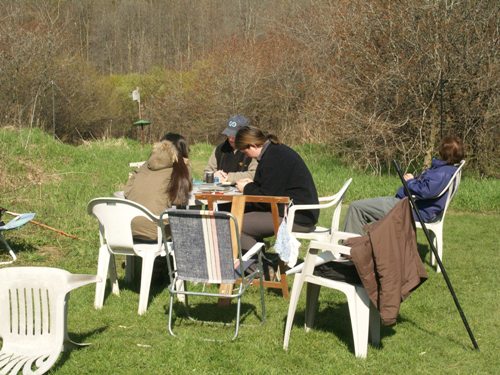 A calm, sunny spring morning was a perfect excuse for moving the banding operations outside for a change! (Photo by Simon Duval) A calm, sunny spring morning was a perfect excuse for moving the banding operations outside for a change! (Photo by Simon Duval) |
Week 6: May 2-8, 2012
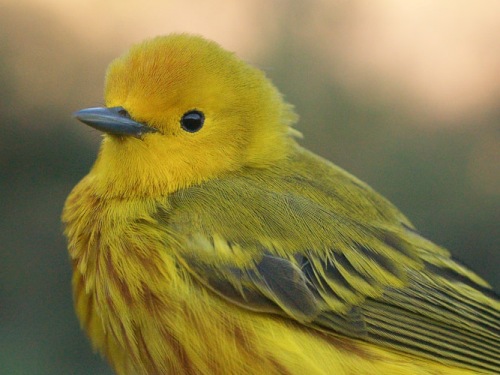 We have featured Yellow Warbler photos on multiple occasions – but at this time of year we are always so happy to have them back that it seems like the most appropriate choice to feature this week. (Photo by Simon Duval) We have featured Yellow Warbler photos on multiple occasions – but at this time of year we are always so happy to have them back that it seems like the most appropriate choice to feature this week. (Photo by Simon Duval) |
| THIS WEEK | THIS SPRING | 2012 TOTAL | SITE TOTAL | |
|---|---|---|---|---|
| # birds (and species) banded | 141 (22) | 315 (33) | 390 (35) | 36141 (108) |
| # birds (and species) repeat | 27 (9) | 88 (11) | 102 (14) | 6515 (68) |
| # birds (and species) return | 17 (6) | 49 (10) | 75 (10) | 1036 (38) |
| # species observed | 88 | 107 | 108 | 205 |
| # net hours | 408.0 | 1143.0 | 1206.8 | 60305.9 |
| # birds banded / 100 net hours | 34.6 | 27.6 | 32.3 | 59.9 |
Note: table does not include nocturnal banding (owls)
Banders-in-charge: Simon Duval, Gay Gruner
Assistants: Christine Barrie, Richard Beauchamp, Normand Beaudet, Nicolas Bernier, Sue Bishop, Emily Boulanger, Yolande Cossette, David Davey, Jean Demers, Tammy Elliot, Jessica Fiset, Liette Fortier, Louise Gagné, Alison Hackney, Frederic Hareau, James Junda, Lisa Keelty, Benoit Laliberté, Francine Marcoux, Benoit Piquette, Catherine Russell, Ahmad Shah, Marilou Skelling, Jane Sorensen, Patricia Stotland, Clémence Soulard, Elise Titman, Joost Valkenburg, Monique Venne
Notes: Although we lost another two days to rain this week, migration on the whole was strong. The 141 birds banded this week was well above average for this point in spring, and only barely behind the week 6 record of 148 set back in 2006. Repeats and returns were also in higher numbers than usual, and the 88 species observed this week was also a near record, just barely behind the 89 counted in 2009. The daily count peaked at 66 on May 5, an unusually early date for such high diversity. After six weeks of observation and three weeks of banding, our season totals in both categories are at near record levels, so we hope that this level of productivity continues over the final four weeks of the season.
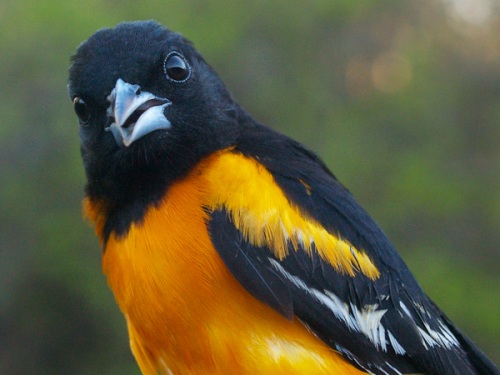 Well, hello! Baltimore Orioles were also among the colourful influx of birds this week, and they often seem to be particularly inquisitive during the banding process. (Photo by Simon Duval) Well, hello! Baltimore Orioles were also among the colourful influx of birds this week, and they often seem to be particularly inquisitive during the banding process. (Photo by Simon Duval) |
Migration took a giant leap forward this week, with 24 species observed for the first time this season. The biggest surprise was Northern Mockingbird, observed for the first time since May 2007. The others were Green Heron, Chimney Swift, Ruby-throated Hummingbird, Great Crested Flycatcher, Eastern Kingbird, Northern Rough-winged Swallow, Warbling Vireo, Blue-headed Vireo, Ovenbird, Northern Waterthrush, Tennessee Warbler, Nashville Warbler, Black-and-white Warbler, Yellow Warbler, Magnolia Warbler, Black-throated Blue Warbler, Blackpoll Warbler, Black-throated Green Warbler, Scarlet Tanager, White-crowned Sparrow, Baltimore Oriole, Bobolink, and Pine Siskin. We also banded 9 species for the first time this spring: Sharp-shinned Hawk, Yellow-bellied Sapsucker, Yellow-shafted Flicker, Blue-headed Vireo, Warbling Vireo, Nashville Warbler, Yellow Warbler, Chipping Sparrow, and Baltimore Oriole. This marks the fourth consecutive spring that we have banded a single Sharp-shinned Hawk (although of course we have four weeks remaining in which to add to the total for this year).
| # individuals banded | mean # individuals observed daily |
|---|---|
| 1. Red-winged Blackbird (50) [1] | 1. Canada Goose (195) [2] |
| 2. White-throated Sparrow (24) [3] | 2. Red-winged Blackbird (71) [1] |
| 3. Ruby-crowned Kinglet (19) [6] | 3. American Crow (54) [3] |
| Common Grackle (9) [5] | Black-capped chickadee (17) [7] |
| 5. American Goldfinch (8) [10] | 5. White-throated Sparrow (16) [5] |
| 6. Tree Swallow (5) [10] | 6. Common Grackle (16) [-] |
| 7. Nashville Warbler (3) [-] | 7. Ring-billed Gull (15) [10] |
| 7. Yellow Warbler (3) [-] | 8. Ruby-crowned Kinglet (14) [8] |
| 7. Swamp Sparrow (3) [4] | 9. Tree Swallow (14) [-] |
| 10. Yellow-bellied Sapsucker (2) [-] | 10. Mallard (12) [9] |
| 10. Warbling Vireo (2) [-] | |
| 10. Yellow-rumped Warbler (2) [-] | |
| 10. Chipping Sparrow (2) [-] | |
| 10. Song Sparrow (2) [6] |
Our “top ten” list of birds banded this week has morphed into a top 14, thanks to a five-way tie for tenth place. Far out in front of all other species was Red-winged Blackbird, taking the top spot in week 6 for the first time since 2006. In the intervening five years, top spot was taken by Ruby-crowned Kinglet three times and White-throated Sparrow twice; these two species rounded out the top three this week. Substantially behind in fourth place was Common Grackle, which usually peaks in week 7, but is perhaps a bit early this year. American Goldfinch squeaked into the top five, as it has in four previous years. The remainder of our extended list includes three sparrows, three warblers, a woodpecker, a swallow, and a vireo. Dropping off from last week’s list were Black-capped Chickadee, American Robin, and Fox Sparrow.
Among the birds observed, there was a more clear-cut top ten. Canada Goose returned to top spot this week, which is where it hsa been in week 6 every year but 2006 (when it was displaced only by a giant flight of Snow Geese). Red-winged Blackbird was the week 6 runner-up for the fourth consecutive year, followed relatively closely by American Crow. After that there was a substantial drop-off to the remaining seven species in the top ten, all of which differed only slightly in abundance. Black-capped Chickadees were more abundant than any previous year at this time, while White-throated Sparrow ranked fifth for a third week in a row, although traditionally their numbers are tapering off at MBO by week 6. The rest of the list includes a mix of common early spring species, three of which were also in the bottom half of the top ten last week (Mallard, Ring-billed Gull, and Ruby-crowned Kinglet), and two which have been around for a while already, but increased in numbers this week (Tree Swallow and Common Grackle). American Robin and Song Sparrow dropped off from last week’s list. This is the third year in a row that Song Sparrow has missed the top ten in week 6, after being on the list annually for the first five years of the Spring Migration Monitoring Program.
On a closing note for this week, we have received a report from the Bird Banding Office about a Brown Thrasher that we banded at MBO as a hatch-year bird in August 2010. It was found this week in Laval, the data unfortunately available thanks to the “help” of a cat. Nevertheless, it is interesting to know that this bird completed two migration cycles, and was back within a handful of kilometres of where it was banded.
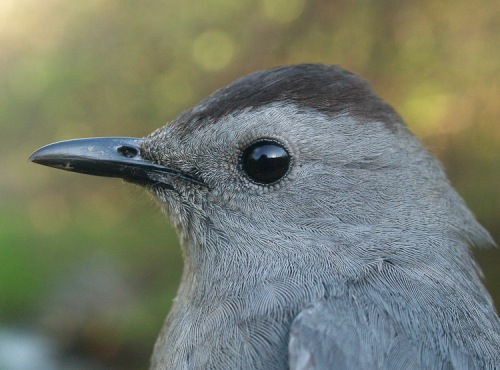 Although less showy than the Baltimore Orioles, Gray Catbirds return to MBO around the time, and are also welcome as a familiar sight, both as migrants and residents. (Photo by Simon Duval) Although less showy than the Baltimore Orioles, Gray Catbirds return to MBO around the time, and are also welcome as a familiar sight, both as migrants and residents. (Photo by Simon Duval)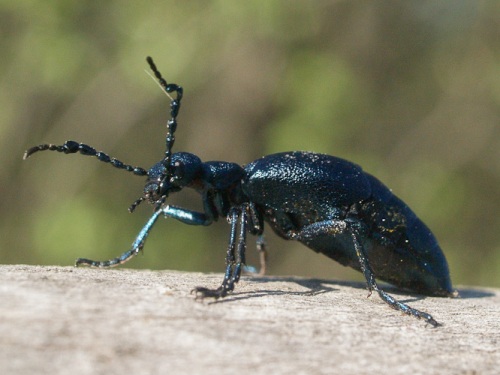 For variety, here is an oil beetle (aka blister beetle, genus Meloe) – thanks to Nicki Fleming for assistance with identification! (Photo by Simon Duval) For variety, here is an oil beetle (aka blister beetle, genus Meloe) – thanks to Nicki Fleming for assistance with identification! (Photo by Simon Duval) |
Week 7: May 9-15, 2012
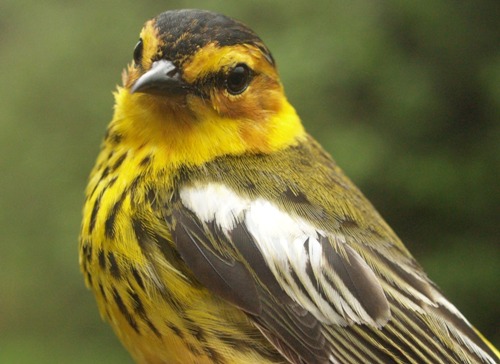 This is one of three Cape May Warblers we banded on May 9, an impressive count, given that we have only had 5 in total over the past seven spring seasons! Visit our Facebook page for a photo of all three together, as well as ongoing updates throughout each week. (Photo by Simon Duval) This is one of three Cape May Warblers we banded on May 9, an impressive count, given that we have only had 5 in total over the past seven spring seasons! Visit our Facebook page for a photo of all three together, as well as ongoing updates throughout each week. (Photo by Simon Duval) |
| THIS WEEK | THIS SPRING | 2012 TOTAL | SITE TOTAL | |
|---|---|---|---|---|
| # birds (and species) banded | 221 (40) | 536 (53) | 611 (55) | 36363 (108) |
| # birds (and species) repeat | 64 (17) | 152 (22) | 166 (25) | 6579 (69) |
| # birds (and species) return | 28 (8) | 77 (13) | 103 (14) | 1064 (38) |
| # species observed | 96 | 129 | 130 | 205 |
| # net hours | 467.0 | 1610.0 | 1674.8 | 60772.9 |
| # birds banded / 100 net hours | 47.3 | 33.3 | 36.5 | 59.8 |
Note: table does not include nocturnal banding (owls)
Banders-in-charge: Simon Duval, Gay Gruner
Assistants: Christine Barrie, Richard Beauchamp, Nicolas Bernier, Cindy Bouchard, David Davey, Rui De Jesus, Leah den Besten, Tammy Elliot, Jessica Fiset, Barbara Frei, Liette Fortier, Louise Gagné, Nathalie Gendron, Alison Hackney, James Junda, Catherine Langevin, Barbara MacDuff, Francine Marcoux, Betsy McFarlane, Sabrina Rochefort, Catherine Russell, Marilou Skelling, Jane Sorensen, Elise Titman, Jay VanderGaast, Monique Venne, Yifu Wang
Notes: Our successful spring season continued this week, with numbers across the board again well above average compared to our previous seven years. The weather was generally cooperative this week, with only Sunday partly compromised by rain. The number of birds banded this week is the second highest ever for spring, and our cumulative total to date of 535 is far ahead of the previous record of 479 at this point in the season. Repeats and returns are also on a record pace – it is too early to know whether these trends will continue to the end of spring, but so far we are very pleased with the results! Species diversity remains well above average too, with the 96 species observed this week just ahead of the previous week 7 record of 95 in 2009, and the season total of 127 just one behind the pace of that same year. The daily estimated total peaked this week at 70 species on May 12, the third highest single-day total ever at MBO (behind 71 on May 30, 2007, and 75 on May 18, 2009). The rest of the week was good too, with daily counts ranging from 47 to 66 species, including as many as 16 warbler species in a single morning.
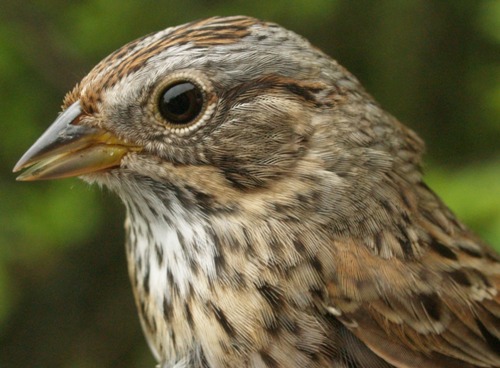 Lincoln’s Sparrow is an uncommon spring migrant at MBO, with only 38 banded over the previous 7 years – but this week alone we banded 6 individuals. Most looked like the one above, but we also had an unusually pale individual, shown below. (Photos by Simon Duval) Lincoln’s Sparrow is an uncommon spring migrant at MBO, with only 38 banded over the previous 7 years – but this week alone we banded 6 individuals. Most looked like the one above, but we also had an unusually pale individual, shown below. (Photos by Simon Duval) |
It was another busy week for new arrivals, with 22 more species recorded for the first time this year – 3 waterbirds (Cackling Goose, Pied-billed Grebe, Spotted Sandpiper), 2 raptors (Bald Eagle, Peregrine Falcon), 2 flycatchers (Least and Traill’s), 2 vireos (Red-eyed and Philadelphia), 3 thrushes (Veery, Wood Thrush, Eastern Bluebird), 7 warblers (Northern Parula, Black-and-white, Cape May, Blackburnian, Chestnut-sided, Bay-breasted, and Wilson’s), 2 finches (Rose-breasted Grosbeak and Indigo Bunting), and a sparrow (Lincoln’s). Similarly, our list of species took a giant leap forward this week to a total of 53 – a full eight species ahead of our previous record pace in 2008. The 20 species added this week comprised 2 flycatchers (Least and Traill’s), 2 thrushes (Veery and Wood Thrush), 2 mimids (Gray Catbird and Brown Thrasher), 10 warblers (Northern Waterthrush, Tennessee, American Redstart, Black-and-white, Cape May, Black-throated Blue, Magnolia, Chestnut-sided, Common Yellowthroat, and Wilson’s), 3 sparrows (Lincoln’s, White-crowned, and Slate-colored Junco), plus Rose-breasted Grosbeak. Also of note this week we had a repeat Rusty Blackbird, the first time ever that we have had one hang around at MBO and get recaptured.
| # individuals banded | mean # individuals observed daily |
|---|---|
| 1. Yellow-rumped Warbler (41) [10] | 1. Canada Goose (128) [1] |
| 2. Red-winged Blackbird (19) [1] | 2. Red-winged Blackbird (58) [2] |
| 3. Tennessee Warbler (16) [-] | 3. Ring-billed Gull (43) [7] |
| 4. Yellow Warbler (13) [7] | 4. American Crow (30) [3] |
| 5. Ruby-crowned Kinglet (10) [3] | 5. Yellow Warbler (21) [-] |
| 5. Nashville Warbler (10) [7] | 6. Baltimore Oriole (18) [-] |
| 7. Magnolia Warbler (8) [-] | 7. Common Grackle (17) [6] |
| 7. White-crowned Sparrow (8) [-] | 8. Yellow-rumped Warbler (16) [-] |
| 9. Warbling Vireo (6) [10] | 9. Greater Snow Goose (14) [-] |
| 9. Gray Catbird (6) [-] | 10. Black-capped Chickadee (14) [4] |
| 9. Northern Waterthrush (6) [-] | |
| 9. Lincoln’s Sparrow (6) [-] | |
| 9. Baltimore Oriole (6) [-] |
We often see rather gradual transitions in species dominance as the season progresses, but this week we saw some rather substantial contrasts compared to last week, with 8 species dropping off from last week’s list of top species banded, and seven new entries this week (the discrepancy accounted for by both weeks having a five-way tie at the bottom of the list, but for 9th place this week and 10th last week). Yellow-rumped Warbler jumped from last week’s tenth place tie to take top spot this week with more than twice as many individuals as Red-winged Blackbird in second – and this is the second highest weekly total ever for Yellow-rumped Warbler in spring. The total number of Red-winged Blackbirds for this spring is now up to 103, already the best season total since 2008, and with more likely yet to come. Perhaps the biggest surprise this week was the unusually early influx of Tennessee Warblers, since over our previous 7 spring programs, we have banded a grand total of just 3 individuals in week 7, compared to 16 this year! Other noteworthy species in this week’s list include Warbling Vireo (more banded this week than in any full spring season since 2007), and Lincoln’s Sparrow (a single week record for spring). Dropping off the list were four of last week’s top six species (Tree Swallow, White-throated Sparrow, Common Grackle, American Goldfinch), as well as Yellow-bellied Sapsucker and three sparrows (Chipping, Song, Swamp).
The transition was a bit less dramatic among species observed, with only four new entries to the top ten this week. Canada Goose and Red-winged Blackbird continued as the two most dominant species. For Canada Goose, this marks the fourth year in a row topping the list for week 7, a sharp contrast to our first four spring monitoring programs, when it ranked between second and ninth in three years, and missed the top ten entirely in 2006 – it certainly seems that there has been a change in their spring movement patterns over this short period. Continuing the trend of early migrants, the mean daily count of 21 Yellow Warblers is the highest we have ever recorded for week 7, and this is only the fifth time in eight years that the species has been among the ten most frequently observed birds at this point in spring (and the first time in the top five). Conversely, this is the latest in spring that we have ever seen Snow Geese – further evidence of the complexities of migration! Species displaced from last week’s top ten were Mallard, Tree Swallow, Ruby-crowned Kinglet, and White-throated Sparrow.
 This Wood Thrush banded on the final day of this week was only the fifth ever banded at MBO, and just the second in spring, the previous one coming in May 2010. (Photos by Simon Duval) This Wood Thrush banded on the final day of this week was only the fifth ever banded at MBO, and just the second in spring, the previous one coming in May 2010. (Photos by Simon Duval) |
It’s hard to believe, but we already are down to our final three weeks of spring migration! Week 8 has on average been our busiest week of the season, so we are hoping that weather holds up and that the results so far this season are a promising indicator of what is awaiting us next….
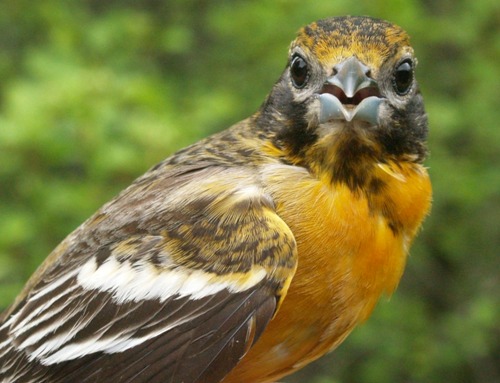 Although superficially easy to age and sex, Baltimore Orioles can sometimes prove tricky even for experienced banders. After some deliberation, we concluded this is an after-second-year female, based on the lack of molt limits on the wing and a relatively dark head. (Photos by Simon Duval) Although superficially easy to age and sex, Baltimore Orioles can sometimes prove tricky even for experienced banders. After some deliberation, we concluded this is an after-second-year female, based on the lack of molt limits on the wing and a relatively dark head. (Photos by Simon Duval)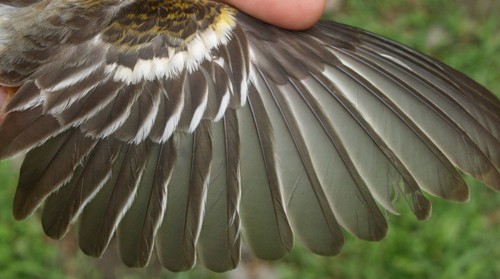 |
Week 8: May 16-22, 2012
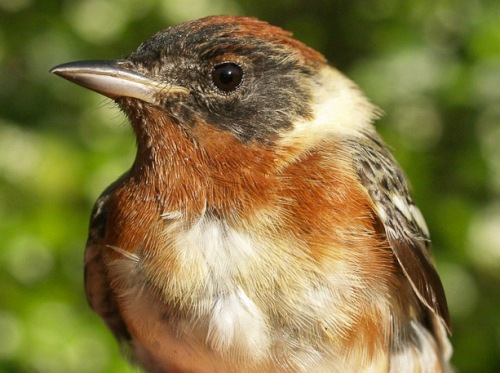 For the second week in a row, our feature bird is one of the spruce budworm specialists. This second-year male Bay-breasted Warbler was our first this spring and only our 34th ever – making this the fifth scarcest of the 26 warbler species we have banded at MBO since 200(Photo by Simon Duval) For the second week in a row, our feature bird is one of the spruce budworm specialists. This second-year male Bay-breasted Warbler was our first this spring and only our 34th ever – making this the fifth scarcest of the 26 warbler species we have banded at MBO since 200(Photo by Simon Duval) |
| THIS WEEK | THIS SPRING | 2012 TOTAL | SITE TOTAL | |
|---|---|---|---|---|
| # birds (and species) banded | 202 (32) | 738 (60) | 813 (61) | 36564 (108) |
| # birds (and species) repeat | 64 (17) | 216 (26) | 230 (29) | 6643 (69) |
| # birds (and species) return | 12 (6) | 89 (14) | 115 (15) | 1076 (38) |
| # species observed | 95 | 135 | 136 | 205 |
| # net hours | 480.0 | 2090.0 | 2153.8 | 61252.9 |
| # birds banded / 100 net hours | 40.6 | 35.3 | 37.7 | 59.7 |
Note: table does not include nocturnal banding (owls)
Banders-in-charge: Simon Duval, Gay Gruner
Assistants: Christine Barrie, Nicolas Bernier, Cindy Bouchard, David Davey, Rui De Jesus, Leah den Besten, Réjean Duval, Barbara Frei, Louise Gagné, Alison Hackney, James Junda, Lisa Keelty, Barbara MacDuff, Francine Marcoux, Betsy McFarlane, Scott Pemberton, Lisa Rosenberger, Catherine Russell, Marilou Skelling, Jane Sorensen, Patricia Stotland, Jay VanderGaast, Yifu Wang
Notes: Although the final day of the week was completely rained out, we were able to operate full hours on all other days, and overall our totals were only slightly lower than last week. We banded just over 200 more birds, bringing the season total to 738, far ahead of the previous record pace of 622 at this stage of the season. Our 216 repeats for the season are also well above average thanks to a substantial boost this week, reflecting that a good number of birds stayed around for at least a day or two before continuing on their way (or in some cases, settling down at MBO for the summer). The 89 returns so far this spring is also near record pace, showing good overwinter survival by òur`birds. Again this week the number of species observed was in the mid-90s and the season total of 135 is above our long-term average at this point in spring. Aside from our rainy day, daily counts were consistently good, ranging from 52 to 65 species.
It is worth noting though that even though numbers are good overall this spring, that does not mean trends are positive for all species. Of particular concern is a sharp decline this year in the number of Cliff Swallows observed, reflected not only in those observed feeding around Stoneycroft Pond, but also through follow-up checks at the nearby breeding colony. A wide variety of aerial insectivores have suffered significant declines in recent years; to date Cliff Swallows have not been highlighted, but perhaps this is a warning sign that they are not immune to the broader trend.
 On May 17, we banded an impressive 22 Tennessee Warblers – 6 of which we had at the same time. Whenever we get many individuals of a particular species, there is a better chance of finding one or two that deviates from the norm a bit. This week we had a second-year male Tennessee Warbler with a distinct hint of rust on its crown – something that occasionally occurs on after-second-year males, but supposedly not younger ones. (Photos by Simon Duval) On May 17, we banded an impressive 22 Tennessee Warblers – 6 of which we had at the same time. Whenever we get many individuals of a particular species, there is a better chance of finding one or two that deviates from the norm a bit. This week we had a second-year male Tennessee Warbler with a distinct hint of rust on its crown – something that occasionally occurs on after-second-year males, but supposedly not younger ones. (Photos by Simon Duval)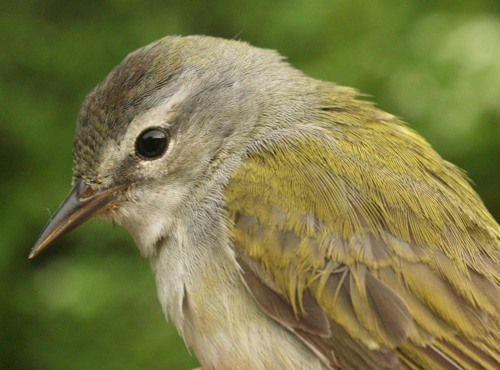 |
At this point in the season, it becomes more difficult to add new species, but there were still half a dozen late arrivals this week. Observed for the first time this year were American Woodcock, Lesser Yellowlegs, Golden-winged Warbler, Orange-crowned Warbler, Mourning Warbler, and Canada Warbler. Two of those warblers (Orange-crowned and Canada) were also among the seven species banded for the first time this spring, along with Hairy Woodpecker, Red-eyed Vireo, Bay-breasted Warbler, Blackpoll Warbler, and Brown-headed Cowbird. Out of that list, only Hairy Woodpecker had been banded earlier in the year during the winter program. The only new addition to our list of species that have returned this year was Purple Finch – more on that bird in this week’s closing series of photos.
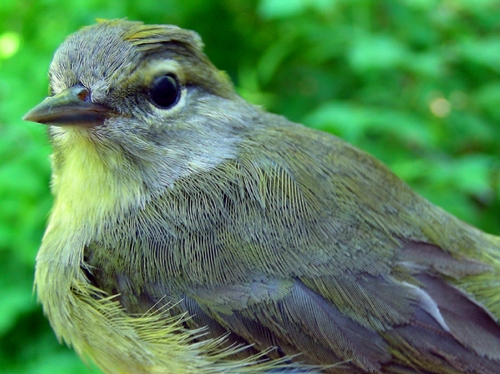 For contrast with the Tennessee Warblers above, here is this week’s Orange-crowned Warbler – only our fourth ever banded in spring. Note the more yellow breast. (Photo by Gay Gruner) For contrast with the Tennessee Warblers above, here is this week’s Orange-crowned Warbler – only our fourth ever banded in spring. Note the more yellow breast. (Photo by Gay Gruner) |
Also of note this week was a Golden-crowned Kinglet that had a stiff right wing which appeared to have healed from a previous injury. It was able to fly well and actually had a good level of fat (4 on a scale of 7), demonstrating nicely how well birds can sometimes recover from injuries that might at first glance appear to pose a grave risk to survival.
| # individuals banded | mean # individuals observed daily |
|---|---|
| 1. Tennessee Warbler (42) [3] | 1. Red-winged Blackbird (41) [2] |
| 2. Magnolia Warbler (18) [7] | 2. American Crow (25) [4] |
| 3. Yellow Warbler (17) [4] | 3. Cedar Waxwing (20) [-] |
| 3. American Goldfinch (17) [-] | 4. Tennessee Warbler (18) [-] |
| 5. Northern Waterthrush (15) [9] | 5. Yellow Warbler (16) [5] |
| 5. Common Yellowthroat (15) [-] | 6. American Goldfinch (13) [-] |
| 7. Cedar Waxwing (9) [-] | 7. Common Grackle (11) [7] |
| 7. Red-winged Blackbird (9) [2] | 8. Tree Swallow (10) [-] |
| 9. Gray Catbird (7) [9] | 8. Black-capped Chickadee (10) [10] |
| 10. American Redstart (5) [-] | 8. Baltimore Oriole (10) [6] |
| 10. Common Grackle (5) [-] |
Week 8 is traditionally when the big wave of warblers reaches MBO, and this year it was particularly true. For just the second time in eight years, the top three species banded in week 8 were all warblers – and there were another three species in the rest of the top ten. Tennessee Warbler took top place, as it did in this week in 2009, but this time by a large margin, with more than twice as many as the runner-up Magnolia Warbler (which in turn has never before ranked this high in spring, although it routinely tops the list for at least a few weeks each fall). We had another good movement of Yellow Warblers this week, with the total of 30 over the past two weeks matching the spring 2011 season total. American Goldfinch came out of nowhere to tie for third place. Rounding out the top five were two more of the warblers, Northern Waterthrush and Common Yellowthroat. Not surprisingly, Red-winged Blackbirds are tapering off, but the 9 extra individuals this week increased their season-leading total to 112. Also of note, the 7 Gray Catbirds this week is a good count, given that spring season totals have ranged from 9 to 15. Overall, there was a fair amount of turnover this week, with seven species dropping off from last week’s list, including three that were in a last-place tie (Warbling Vireo, Lincoln’s Sparrow, and Baltimore Oriole), three others in the bottom half of the list that are early to mid-season migrants (Ruby-crowned Kinglet, Nashville Warbler, and White-crowned Sparrow), and most notably Yellow-rumped Warbler, which topped last week’s list with 41 banded, but largely cleared out, with only 2 more this week.
A similar change occurred on the list of species observed, with Canada Goose dropping from top spot last week with a mean daily count of 128 individuals to way out of the top ten this week with just 2 per day on average! Drastic as this seems, it’s in line with the usual pattern of the last migrant flocks moving on and just a local pair or two remaining – it’s just that the transition occurred later than ever this year. Returning to top spot this week was Red-winged Blackbird, which has also been the most abundant species in week 9 in four of seven previous years. The other three years, Ring-billed Gull was number one – but this week it was relatively scarce, actually landing just outside the top ten. In between were mostly species that are local residents, although of course some individuals likely are migrants moving through as well. The notable exception was Tennessee Warbler, which does not breed at MBO – and which has never before had such a high daily mean count in spring.
Two weeks remain in this year’s Spring Migration Monitoring Program, and just ten days of banding. We have had an excellent season so far and are on pace to break several records if weather and migration remain good. Stay tuned for the final two updates of the season!
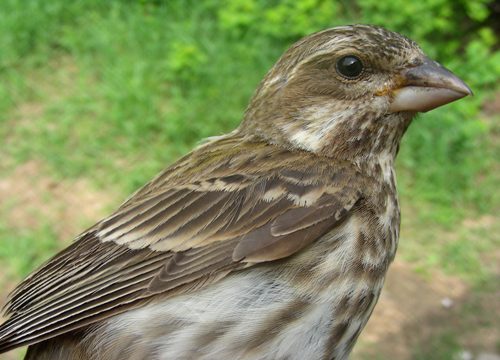 The photo above was taken on May 20, 2007, when we first banded this Purple Finch, which we identified at the time as sex unknown and after-hatch-year, although we suspected it was a second-year bird (we weren’t willing to guess at sex!) (Photo by Marie-Anne Hudson) The photo above was taken on May 20, 2007, when we first banded this Purple Finch, which we identified at the time as sex unknown and after-hatch-year, although we suspected it was a second-year bird (we weren’t willing to guess at sex!) (Photo by Marie-Anne Hudson) 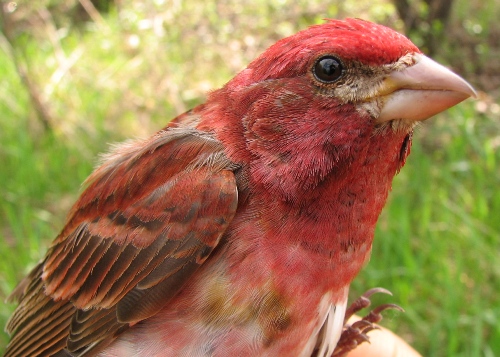 One year and 8 days later, we recaptured the same bird – now clearly a male! Working backward, we could therefore conclude our initial hunch was right, and it was a second-year bird in 2007. Interestingly, there were still some brown patches visible in May 2008, suggesting that in some cases like this, Purple Finches (males at least) may be aged as third-year based on plumage. (Photo by Barbara Frei) One year and 8 days later, we recaptured the same bird – now clearly a male! Working backward, we could therefore conclude our initial hunch was right, and it was a second-year bird in 2007. Interestingly, there were still some brown patches visible in May 2008, suggesting that in some cases like this, Purple Finches (males at least) may be aged as third-year based on plumage. (Photo by Barbara Frei) 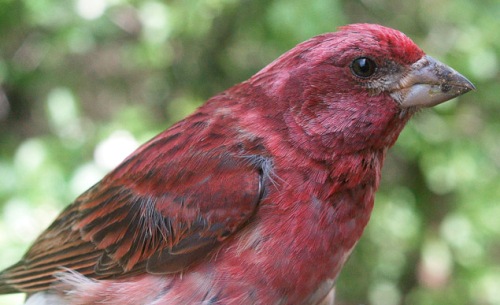 Finally, here is the same bird again, just two days shy of its five-year anniversary of banding, and now in its sixth year. Note the more uniform and deeper purple plumage, compared to the third-year photo above. Perhaps the most peculiar aspect of all this is that despite this bird clearly returning to MBO most years, we have no summer records of the species on site, so either it is an awfully secretive breeder, or perhaps it is stopping in at MBO upon arrival, and then shifting over to nest in the Morgan Arboretum. (Photo by Simon Duval) Finally, here is the same bird again, just two days shy of its five-year anniversary of banding, and now in its sixth year. Note the more uniform and deeper purple plumage, compared to the third-year photo above. Perhaps the most peculiar aspect of all this is that despite this bird clearly returning to MBO most years, we have no summer records of the species on site, so either it is an awfully secretive breeder, or perhaps it is stopping in at MBO upon arrival, and then shifting over to nest in the Morgan Arboretum. (Photo by Simon Duval) |
Week 9: May 23-29, 2012
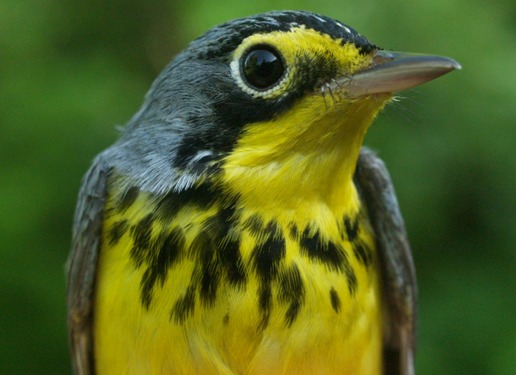 We have featured Canada Warblers many times before, but it’s always hard to resist doing so again. Not only are they striking birds, but they are classified as Threatened under Canada’s Species at Risk Act, and therefore one of our top priorities for monitoring. (Photo by Simon Duval) We have featured Canada Warblers many times before, but it’s always hard to resist doing so again. Not only are they striking birds, but they are classified as Threatened under Canada’s Species at Risk Act, and therefore one of our top priorities for monitoring. (Photo by Simon Duval) |
| THIS WEEK | THIS SPRING | 2012 TOTAL | SITE TOTAL | |
|---|---|---|---|---|
| # birds (and species) banded | 188 (30) | 926 (64) | 1001 (65) | 36752 (108) |
| # birds (and species) repeat | 60 (15) | 276 (28) | 290 (31) | 6703 (69) |
| # birds (and species) return | 10 (7) | 99 (17) | 125 (18) | 1086 (38) |
| # species observed | 80 | 140 | 143 | 206 |
| # net hours | 492.0 | 2582.0 | 2645.8 | 61744.9 |
| # birds banded / 100 net hours | 38.2 | 35.9 | 37.8 | 59.5 |
Note: table does not include nocturnal banding (owls)
Banders-in-charge: Simon Duval, Gay Gruner
Assistants: Christine Barrie, Nicolas Bernier, Sue Bishop, Cindy Bouchard, Carl Bromwich, David Davey, Rui De Jesus, Leah den Besten, Réjean Duval, Tammy Elliott, Louise Gagné, Alison Hackney, Frederic Hareau, James Junda, Lisa Keelty, Louise LeBel, Catherine Leclerc, Asya Malinova, Daniel Martin, Betsy McFarlane, Ana Morales, Catherine Russell, Ahmad Shah, Marilou Skelling, Jane Sorensen, Patricia Stotland, Elise Titman, Rodger Titman
Notes: Except for the last day of the week when rain severely limited our net hours, we had a steady movement of birds throughout the week, with between 21 and 45 individuals banded each morning. That was easily enough to push us past the previous spring record of 906 individuals, set last year – a positive trend! The total of 276 repeats to date is also already a season record, and the 99 returns are within striking distance of the record of 113. On the other hand, diversity was surprisingly low this week, with only 80 species observed, compared to a past average in the low 90s for this time of year. However, the total of 140 for the season is still a bit above average.
Although we saw fewer species than expected this week, among them was a new record for MBO – Black-bellied Plover. Like some of the other shorebirds on our checklist, it was only seen flying over, but that counts for our purposes. It becomes the 206th species observed at MBO since 200 What will be next?
Also noteworthy this week were this year’s first sightings of Great Horned Owl, Willow Flycatcher, Eastern Wood-Pewee, Marsh Wren, and Gray-cheeked Thrush. The latter two were also banded for the first time this year, along with Philadelphia Vireo and Indigo Bunting. We also had our first Blue Jay, Indigo Bunting, and Brown-headed Cowbird returns of 2012. And on a somewhat related note, we heard this week about a Common Grackle we banded at MBO in August 2010, found in Laval on May 6 this year, the report coming (as it often does) thanks to the predatory intervention of a cat.
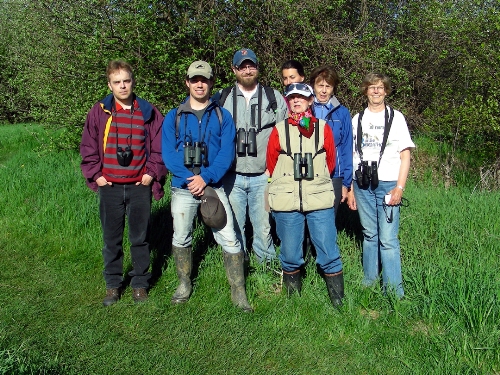 This year’s MBO Green Team, taking a well-deserved break during their busy Birdathon, during which they observed 89 species on foot at MBO and surrounding areas including the Morgan Arboretum – click here for the full report. This year’s team members from left to right: Mike Beaupre, Simon Duval, James Junda, Louise Gagné, Barbara Frei, Francine Marcoux, and Barbara MacDuff (and Richard Beauchamp behind the camera) This year’s MBO Green Team, taking a well-deserved break during their busy Birdathon, during which they observed 89 species on foot at MBO and surrounding areas including the Morgan Arboretum – click here for the full report. This year’s team members from left to right: Mike Beaupre, Simon Duval, James Junda, Louise Gagné, Barbara Frei, Francine Marcoux, and Barbara MacDuff (and Richard Beauchamp behind the camera) |
Aside from mid-May being an exciting time at MBO, it is also an important period for fundraising through the Baillie Birdathon. Again this year we had several efforts dedicated to this cause. As they have been for the past couple of years, the Red-eyed Wearios were by far our most successful fundraisers, this year splitting their effort on Lake Erie in Ontario between Point Pelee (trip report 1) and Long Point (trip report 2). As noted above, the MBO Green Team put in another great effort this year, as usual focusing their search on MBO and adjacent natural areas. Also in southern Quebec, Alison Hackney headed up another foursome of great birders (trip report). Meanwhile, Marcel Gahbauer undertook a solo effort with a challenge to find as many species as possible within a 100 kilometre radius of Calgary, Alberta (126 as it turns out – see the report for details). The Birdathon is MBO’s single most important source of funding – if you value our research and enjoy our reports, please consider taking a couple of minutes to click on one of the underlined names in this paragraph to make a contribution through Bird Studies Canada’s secure online portal (all Canadian donors will automatically receive a charitable tax receipt from BSC in fall). Your support enables us to continue our migration monitoring programs – thank you in advance!
| # individuals banded | mean # individuals observed daily |
|---|---|
| 1. Cedar Waxwing (38) [7] | 1. Red-winged Blackbird (32) [1] |
| 2. Tennessee Warbler (30) [1] | 2. Cedar Waxwing (23) [3] |
| 3. Wilson’s Warbler (16) [-] | 3. American Crow (18) [2] |
| 4. American Goldfinch (14) [3] | 4. Yellow Warbler (12) [5] |
| 5. Magnolia Warbler (13) [2] | 5. American Goldfinch (11) [6] |
| 6. American Redstart (12) [10] | 6. Tennessee Warbler (10) [4] |
| 7. Traill’s Flycatcher (11) [-] | 7. Tree Swallow (9) [8] |
| 8. Blackpoll Warbler (9) [-] | 8. Ring-billed Gull (9) [10] |
| 9. Gray Catbird (6) [9] | 9. Baltimore Oriole (8) [8] |
| 9. Northern Waterthrush (6) [5] | 10. Common Grackle (8) [7] |
A substantial invasion of waxwings accounted for 20% of birds banded this week – a single week record in fact. The sustained strong movement of Tennessee Warblers pushed them to 88 individuals banded this spring, a new record high. Three of our traditional late season arrivals made their debut on the top ten list this week – Wilson’s Warbler (with nearly as many this week as the past two spring seasons combined), Traill’s Flycatcher (with more this week than in 5 of 7 previous entire spring counts), and Blackpoll Warbler (actually a bit less numerous than usual at this point in May). American Goldfinch and Magnolia Warbler slipped down the list slightly from last week, but still had good numbers again this week. Perhaps most interesting though was the count of 12 American Redstarts banded this week, given that on average only 6 have been banded per spring in past years; the season total is now up to 19, which is also a new record. Gray Catbird and Northern Waterthrush round out this week’s top ten, padding season totals that are well above average for both species.
It’s unusual that the ten most abundant species on site remain the same for two weeks in a row, but this is one of those rare occasions. There was a bit of minor shuffling in positions compared to week 8, but no species shifted more than two positions – a remarkable level of consistency! Red-winged Blackbird remained in top spot, as is often the case at this time of year, but Ring-billed Gull has also been the most numerous in week 9 (in 2005, 2006, and 2009), yet was in the lower reaches of the top ten this week. Like last week, Cliff Swallow was notable by its absence from the list, and the continued abundance of Tennessee Warblers is also noteworthy.
As always, the spring has flown by. We have just one week left in our Spring Migration Monitoring Program, including our final three days of banding for the season, and another four days of census to round it out. Watch for our final spring report next week, before we take a short hiatus to focus on our summer program, which will centre around our fourth year operating our MAPS (Monitoring Avian Productivity and Survivorship) station.
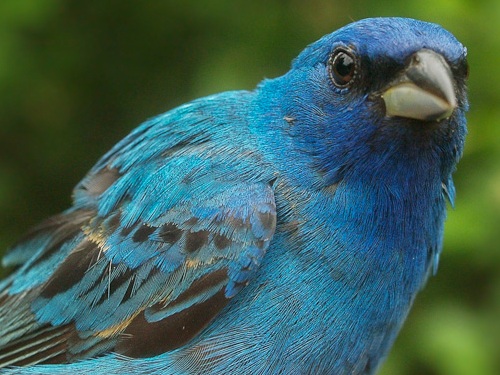 Amid all the May warblers, we always enjoy the splash of blue from Indigo Buntings. (Photo by Simon Duval) Amid all the May warblers, we always enjoy the splash of blue from Indigo Buntings. (Photo by Simon Duval) There are a lot of “intermediate” tails in spring, that are difficult to use for determining age – but this after-second-year Northern Waterthrush had particularly broad and truncate rectrices that left no doubt at all. (Photo by Simon Duval) There are a lot of “intermediate” tails in spring, that are difficult to use for determining age – but this after-second-year Northern Waterthrush had particularly broad and truncate rectrices that left no doubt at all. (Photo by Simon Duval) |
Week 10: May 30 – June 5, 2012
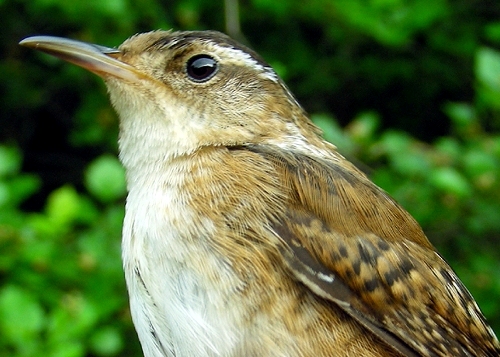 Even with just three banding days in our final week of the season, we managed to get quite a rarity – just our second Marsh Wren ever banded at MBO. (Photo by Gay Gruner) Even with just three banding days in our final week of the season, we managed to get quite a rarity – just our second Marsh Wren ever banded at MBO. (Photo by Gay Gruner) |
| THIS WEEK | THIS SPRING | 2012 TOTAL | SITE TOTAL | |
|---|---|---|---|---|
| # birds (and species) banded | 67 (20) | 993 (66) | 1068 (66) | 36819 (108) |
| # birds (and species) repeat | 22 (14) | 298 (29) | 312 (32) | 6725 (69) |
| # birds (and species) return | 4 (3) | 103 (17) | 129 (18) | 1090 (38) |
| # species observed | 70 | 143 | 144 | 207 |
| # net hours | 236.0 | 2818.0 | 2881.8 | 61980.9 |
| # birds banded / 100 net hours | 28.4 | 35.2 | 37.1 | 59.4 |
Note: table does not include nocturnal banding (owls)
Banders-in-charge: Simon Duval, Gay Gruner
Assistants: Sue Bishop, Cindy Bouchard, David Davey, Jean Demers, Leah den Besten, Tammy Elliott, Barbara Frei, Louise Gagné, Jo-Annie Gagnon, Nathalie Gendron, Alison Hackney, Frederic Hareau, James Junda, Barbara MacDuff, Betsy McFarlane, Harriel Morgan, Chris Murphy, Aubrey Paolino, Benoit Piquette, Catherine Russell, Ahmad Shah, Marilou Skelling, Clémence Soulard, Rodger Titman
Notes: Throughout this spring numbers have been above average, and true to form we ended our eighth annual Spring Migration Monitoring Program on a strong note. The 67 birds we banded was a record high for week 10 (improving on our previous peak of 59 all the way back in our first year, 2005), and pushed us to a season total of 993 birds banded, a nearly 10% increase over the previous record of 906 we set just last spring. Diversity was also well above average, with 66 species banded (tying the record from 2009), and the 143 species observed during the course of the season was above average. The nearly 300 repeats this spring is also a new record, while the 103 returns are only a few behind the record of 113 in 2010.
Also of note is that we added another two species to the MBO site checklist this spring, both of them coming in the final two weeks of the season. Last week, we were lucky to spot a Black-bellied Plover flying overhead. This week, the June 3 census yielded our first Tufted Titmouse – arguably our most “overdue” species, given that some have been seen semi-regularly just a few kilometres away in Baie d’Urfé for several years now. Not surprisingly, aside from the Tufted Titmouse, there were few other additions to our list for the season this week. In fact, Swainson’s Thrush was the only other newcomer – both banded and observed.
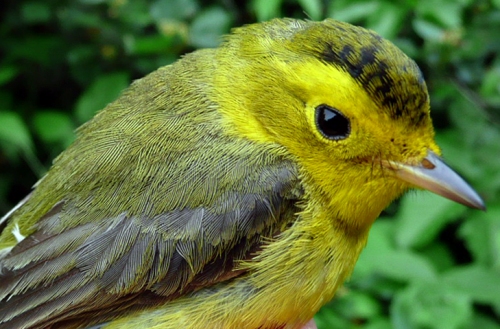 Although breeding birds begin to dominate by the final week of our spring season, there are always still late migrants moving through too, such as this Wilson’s Warbler, but also typically including Blackpoll Warbler and Traill’s Flycatcher (Photo by Gay Gruner) Although breeding birds begin to dominate by the final week of our spring season, there are always still late migrants moving through too, such as this Wilson’s Warbler, but also typically including Blackpoll Warbler and Traill’s Flycatcher (Photo by Gay Gruner) |
We received another interesting recovery from the Bird Banding Office this week. The only Merlin we’ve ever banded at MBO, back in May 2007, was reported from Winchendon, Massachusetts, roughly 340 km southeast of us. It was flagged with an unfamiliar code, which upon research translated into “found dead; band on skeleton only”. How long the bird might have taken to decompose is difficult to know, but given that five years have elapsed since we banded it, it seems highly likely that it survived at least a few more years. Of course it would be interesting to know at what time of year it died and whether it was migrating through northwest Massachusetts or wintering/breeding there … but there are some answers that simple band recoveries can’t give us. All the same, we are very glad to have received this news, and thank all those who make the effort to report band sightings.
| # individuals banded | mean # individuals observed daily |
|---|---|
| 1. Cedar Waxwing (29) [1] | 1. Red-winged Blackbird (32) [1] |
| 2. Blackpoll Warbler (7) [8] | 2. Cedar Waxwing (17) [2] |
| 3. Traill’s Flycatcher (4) [7] | 3. American Crow (15) [3] |
| 3. Wilson’s Warbler (4) [3] | 4. Tree Swallow (8) [7] |
| 3. Red-winged Blackbird (4) [-] | 5. Yellow Warbler (8) [4] |
| 6. Least Flycatcher (2) [-] | 5. Song Sparrow (8) [-] |
| 6. Gray Catbird (2) [9] | 7. Canada Goose (8) [-] |
| 6. Yellow Warbler (2) [-] | 7. Black-capped Chickadee (8) [-] |
| 6. Chestnut-sided Warbler (2) [-] | 9. American Goldfinch (7) [5] |
| 10. 11 species (1) [-] | 10. House Wren (6) [-] |
As always for the final week of spring, the top ten species banded are based on just three days. Considering that, Cedar Waxwing had a particularly strong showing, with nearly as many individuals banded as in the previous full week. That pushed the season total of Cedar Waxwing to 77, narrowly eclipsing the previous spring record of 72 from two years ago. The rest of the species were present in much lower numbers. Blackpoll Warbler is one of the traditional late spring migrants, and made the top two for the fifth time in the past six years. Following close behind were the other two late spring regulars, Traill’s Flycatcher and Wilson’s Warbler. Somewhat surprisingly, we also banded four more Red-winged Blackbirds – by this time they have been on site for a while, but it seems that a few managed to elude us this long at least. Rounding out the list, we had four species tied at 2, and another tied with one individual each. Migrants falling off the list from last week were Northern Waterthrush, American Redstart, and Magnolia Warbler.
Full results for the season will be published in our annual report at the end of the year. For now, a sneak preview of the banding totals for spring. The top ten species, in order, were Red-winged Blackbird, Tennessee Warbler, Cedar Waxwing, White-throated Sparrow, Ruby-crowned Kinglet, American Goldfinch, Yellow-rumped Warbler, Magnolia Warbler, Yellow Warbler, and Northern Waterthrush. Despite the overall record number of birds banded this spring, only two species in the top ten (Tennessee Warbler and Cedar Waxwing) and six others (House Wren, Hermit Thrush, Gray Catbird, Nashville Warbler, American Redstart, and Purple Finch) were at record highs individually; rather it seems that most species were banded in above average numbers. This is reflected in just two species being unusually uncommon. For the second year in a row, we banded just one Rose-breasted Grosbeak, a notable departure from our previous spring average of 7. The other significant low was Slate-colored Junco, with also just one banded, compared to a long-term average of nearly 17. However, this is likely a function of the early spring triggering them to move north earlier than usual, largely missing our banding season.
The top three species observed in week 10 maintained their rank from last week, and the mean daily count of Red-winged Blackbirds in fact remained unchanged too. Yellow Warbler and American Goldfinch dropped down the list a bit, and Tree Swallow moved up a few spots. The four new additions this week are all summer residents – Song Sparrow, Canada Goose, Black-capped Chickadee, and House Wren. Of course, most of those have been around in good numbers throughout spring, but their relative abundance is more prominent once migrants have passed through. That being said, two of the species they displaced from last week’s top ten (Baltimore Oriole and Common Grackle) are also local breeders, while Ring-billed Gull is also in the area throughout the summer; only Tennessee Warbler has moved on for the next while, to return as molt migrants beginning already in late July. Astute readers will note an odd pattern in the list, with five species having a mean daily count of 8 individuals, yet being ranked as fourth, fifth (two species), and seventh (two species). This is not an error, just a product of our rounding/ranking approach – we round the mean to the nearest whole number for ease of comparison, but still rank them based on actual means. In this case, we on average observed 8.0 Tree Swallows per day, 7.7 Yellow Warblers and Song Sparrows, and 7.6 Canada Geese and Black-capped Chickadees.
And so another successful spring migration monitoring program has come to an end – our eighth in a row! As always, we could not have done it without the dedication of our banders, extractors, censusers, scribes, and other volunteers. Sincere thanks to all who contributed over the past ten weeks, and we look forward to all of you joining us again for our fall migration monitoring program, beginning as always on August 1.
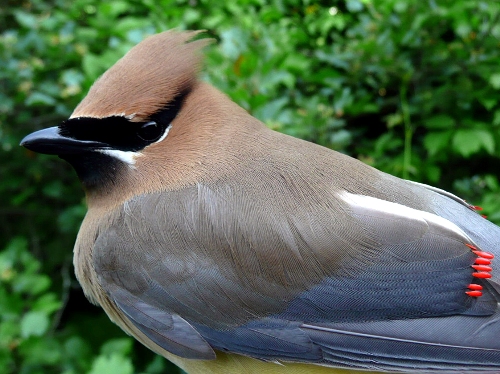 Cedar Waxwings were by far the most dominant bird in the nets in our final week. (Photo by Gay Gruner) Cedar Waxwings were by far the most dominant bird in the nets in our final week. (Photo by Gay Gruner)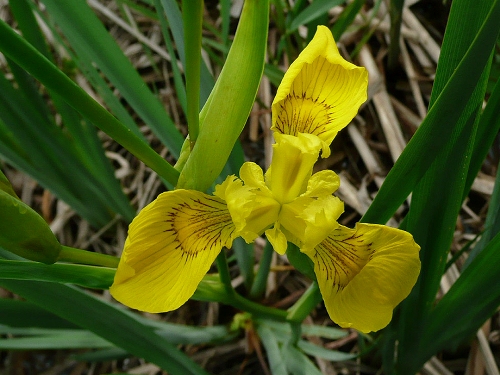 Aside from the birds, MBO is also alive with flowers in spring – the Yellow Flag Iris along the borders of Stoneycroft Pond is always one of the highlights. (Photo by Gay Gruner) Aside from the birds, MBO is also alive with flowers in spring – the Yellow Flag Iris along the borders of Stoneycroft Pond is always one of the highlights. (Photo by Gay Gruner) |